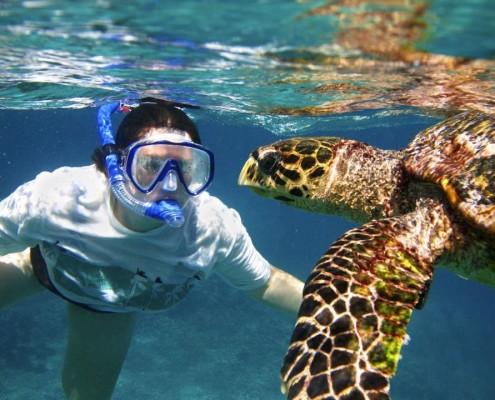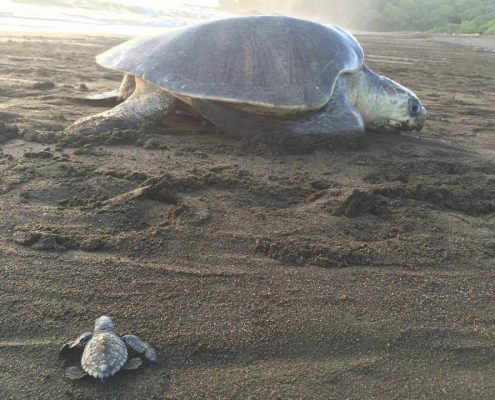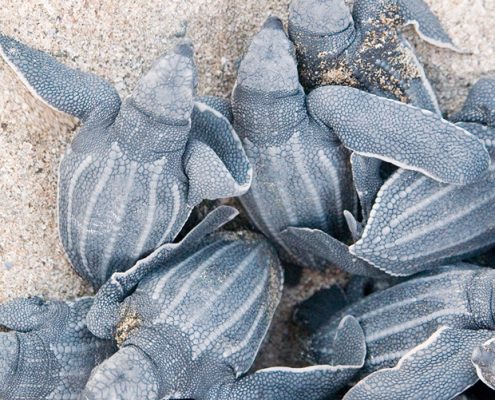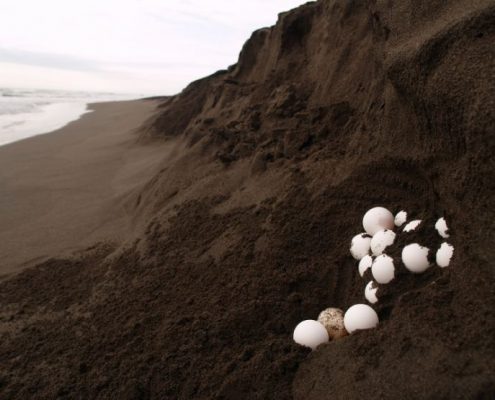The official log may record about two million visitors to Costa Rica every year, but that number doesn't include the additional tens of thousands of sea turtles that grace our beaches. Indeed – Costa Rica turtle nesting is a Big Deal here on the Rich Coast.
Year after year, five species of sea turtles – olive ridleys, leatherbacks, loggerheads, hawksbills, and green sea turtles – come to shore every year. These gentle sea giants, which are classified as vulnerable, endangered and critically endangered species, lay hundreds of thousands of eggs on Costa Rican beaches. Weeks later, their tiny hatchlings emerge from sandy nests, to make their way to the sea.
Whether you're a fierce animal lover, a wildlife conservationist, or just your average tourist, sea turtle nesting is a must for your To Do list. The sight itself, not to mention the environmental significance, are not only incredible to witness but also deeply moving – something everyone should see for themselves, at least once.
Costa Rica turtle nesting happens year-round on both the Pacific and Caribbean coasts, although your chances of spotting turtles increase during the green season months of May through November. So, where and when should you book a turtle tour? We have all the info you need.

First things first: guided turtle tours are the way to go, if you want to see sea turtles in Costa Rica.
Why? Well, to start, an official tour is often the only legal way to watch sea turtles nest. And even when it isn't, guided tours keep turtles safe. A good tour is environmentally responsible, taking care to protect nesting sites, turtles, turtle nests, and the new hatchlings.
Often, you can arrange a guided turtle tour directly with a park ranger through a national park. When that's not an option, ask around for a licensed guide. You'll know an eco-responsible tour when you see it: they'll make it clear that brightly colored clothing, flash photography, and video are strictly prohibited, as turtles are extremely sensitive to ambient light.
When turtle-watching, keep your environmental impact to a minimum. Across the board, sea turtle species range from vulnerable to critically endangered: please don't do anything that could possibly affect their nesting and/or hatching!

Before we get to the where & when, a little background on Costa Rica turtle nesting: Five species and one sub-species – well, one sub-species for now; whether it becomes its own species is a topic of hot debate – live here: hawksbill, leatherback, loggerhead, olive ridley, and green sea turtles, as well as the sub-species black sea turtle. All six marine turtles nest here, on both the Pacific and Caribbean coasts.
Green Sea Turtle (Chelonia mydas)
Status: Endangered
Green sea turtles – also known as green turtles, black sea turtles (currently considered a sub-species), and Pacific green turtles – grow up to 4 feet and ~350 pounds, and live approximately 80 years in the wild. They are found in both the Pacific and the Atlantic/Caribbean, as well as in the Indian Ocean, and are known to migrate long distances between their primary feeding grounds and nesting beaches. Interestingly, when it comes time to nest, most green sea turtles return to very beach on which they were hatched.
In Costa Rica, green sea turtles nest primarily in Tortuguero National Park, the largest green turtle nesting site in the Western Hemisphere, from which the majority of all Caribbean green sea turtles hail.
Hawksbill Sea Turtle (Eretmochelys imbricata)
Status: Critically Endangered
Known for its unique hooked bill, similar to a hawk's, hawksbill sea turtles are medium-sized at 3 feet long and 100-150 lbs. They are the most tropical of all sea turtles, sticking closely to the warm waters of the Atlantic, Pacific, and Indian Oceans. They only nest at intervals of two+ years, but during their nesting season they'll nest two to four times.
In Costa Rica, hawksbill sea turtles are most common in the Caribbean turtle hotspot of Tortuguero.
Leatherback Sea Turtle (Dermochelys coriacea)
Status: Vulnerable
The massive leatherback sea turtle – also, lute turtle, leathery turtle, or simply the luth – is the world's largest living turtle, at 8 feet and up to 1,500 lbs. It's also the fourth-largest of all reptiles, second only to three crocodilians. In addition to its size, the leatherback's most distinctive feature is its lack of traditional turtle shell; instead, its body is covered with a leather-like confection of oily skin and flesh.
In Costa Rica, leatherbacks nest on both Caribbean and Pacific beaches.
Loggerhead Sea Turtle (Caretta caretta)
Status: Vulnerable
Named for their comparatively large heads, loggerhead sea turtles measure about 3 feet long and 150-500 lbs. at maturity; the very largest loggerheads can grow up to a striking 1,000 lbs. Even more remarkable: from hatchling to adult, these ocean wonders increase their weight more than 6,000 times – a pretty impressive feat!
In Costa Rica, loggerheads are uncommon but are occasionally spotted in Tortuguero.
Olive Ridley Sea Turtle (Lepidochelys olivacea)
Status: Endangered / Vulnerable
Olive ridley sea turtles, sometimes called Pacific ridley sea turtles, are on the small size at around 2 feet long and 55-110 lbs. They are the most abundant sea turtle in the world – and even so, they're still an endangered or vulnerable species, depending on the measurement. Olive ridleys are unique in that they often nest in arribadas: mass nesting events, during which thousands of turtles nest over several nights. Arribadas usually occur around the new moon.
In Costa Rica, olive ridleys are most common on the Pacific coast. Arribadas are common at Playa Ostional and Playa Nancinte, with annual nesting calculated at 600,000 to 750,000 turtles.
North Pacific

The North Pacific – from Tamarindo's Las Baulas National Marine Park, south through Ostional on the Nicoya Pensinsula – is one of two hotspots for Costa Rica sea turtle nesting.
Let's start in the north: Las Baulas National Marine Park, located just north of Tamarindo, encompasses all of Playa Grande. This is Costa Rica's most important nesting site for leatherback turtles; nesting season runs from October through March.
Head south to Samara, and you'll hit Playa Camaronal, nesting site to leatherback turtles, olive ridleys, hawksbills, and black sea turtles. Nesting occurs year-round, but is most common during the rainy season months of May through November. Camaronal's turtle hatchery, headlined by Costa Rica's marine turtle restoration program (PRETOMA), is well protected by both the law and responsible citizens, making it a critical nesting site for these endangered creatures.
On the Nicoya Peninsula, Ostional National Wildlife Refuge is the spot for olive ridley arribadas – those mass-nesting events that bring hundreds, if not thousands of turtles ashore every night. Arribadas are common from May through November, but are most common between August and October.
Central Pacific
Just south of Dominical, Ballena National Marine Park (the famed whale's tale) hosts both olive ridley and hawksbill turtles. High nesting season runs May through November.
Southern Pacific
The Osa Peninsula – Costa Rica's last frontier, isolated and often completely wild – may not have all-day electricity or other creature comforts, but it does have marine turtles. Black sea turtles, specifically, which nest year-round. Hawksbills are also present.
The Osa Sea Turtle Conservation Program works to protect the peninsula's endangered marine turtles, as well as to protect their important nesting grounds.
Northern Caribbean
The second Costa Rica turtle nesting hotspot is the northern Pacific town of Tortuguero, home to four of the world's eight sea turtle species: Leatherbacks, hawksbills, loggerheads, and green sea turtles all nest here. Leatherbacks nest from March through May; hawksbills are found in Tortuguero from March to October; loggerheads are less common, but come to shore July through October; and green sea turtles are in town between July and October.
Southern Caribbean

Though not as famous as its northern brother, the southern Caribbean hosts its fair share of sea turtles. Your best chances of spotting nesting mothers are in the Gandoca-Manzanillo Wildlife Refuge, at the very southern tip of Costa Rica, where turtle nesting typically peaks from April through October.
A local conservation association, ANAI, researches turtle habitats and, specifically, nesting leatherbacks and their nesting habitats. Hawksbills are also spotted here, usually along the shores of Playa Negra. (Note: There are many Costa Rican beaches called Playa Negra; we're talking about the one within the Gandoca-Manzanillo Wildlife Refuge.)
Costa Rica Turtle Nesting Tours

Sea Turtle Species in Costa Rica

Status: Critically Endangered
Status: Vulnerable
Status: Vulnerable
Status: Endangered / Vulnerable
Costa Rica Turtle Nesting: When & Where
Costa Rica's five sea turtle species and one subspecies swim the seas from north to south, on both the Caribbean and Pacific coasts. And that means that, no matter where you are, your chances are good of spotting one of these gentle giants. Here's the where and when:

Sea Turtles: Fun Facts
Sea turtles are pretty fascinating creatures. In the spirit of fun and the wonder that they inspire, here are a few of our favorite (and weird) sea turtle facts:- Temperature determines sex: A turtle's sex isn't determined upon fertilization, but rather during incubation. During the all-important, sex-determining two weeks of incubation, cool sands (under 81ºF / 27º C) make males and warm sands (over 86ºF / 30º C) breed females.
- Unfertilized eggs: Up to half of all sea turtle eggs are smaller, sterile and yolk-less. They'll never develop into turtles.
- Cold blooded, or... ?: Sea turtles aren't strictly cold blooded; they can actually raise their body temperature up to 18ºF (8ºC) above the ambient water temperature.
- Non-retractable heads: Unlike their smaller land-lubbing brethren, sea turtles cannot retract their heads into their shells. That said, their skulls are roofed with heavy bone to protect their heads and neck, if need be.
- Fish-like breathing: They can also submerge themselves for up to three hours – more like a fish than an air-loving reptile!
- Homing signal: Most sea turtles – leatherbacks are a notable exception – return to nest on the same beaches where they were born. This can be a journey of thousands of miles! Double fun fact: Some scientists purport that the Earth's magnetic field imprints these locations on hatchlings. Others hypothesize that sea salt/water/beach scents are what serve as the turtles' homing signals.
- Mating by sea: At least in Costa Rica, sea turtles mate exclusively in the ocean. Only the females come ashore.
- Sperm hoarders: Speaking of mating, males aren't always necessary! After mating, female marine turtles can store sperm for several years, fertilizing their eggs when necessary.
- Turtle-palooza: During an arribada, or mass nesting, up to 20,000 sea turtles can come to shore in a single night. Imagine that sight. (Or don't imagine; come and see for yourself!)


